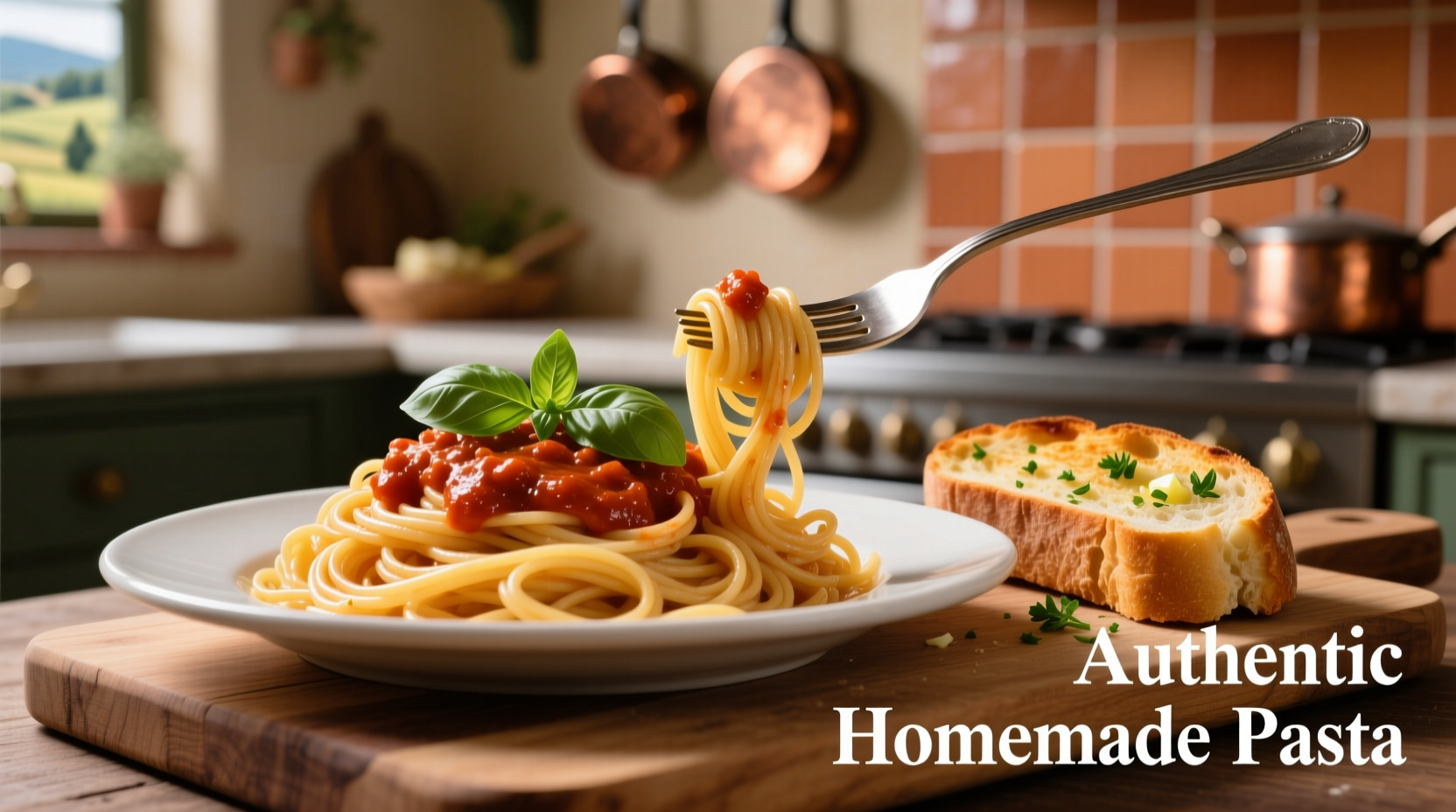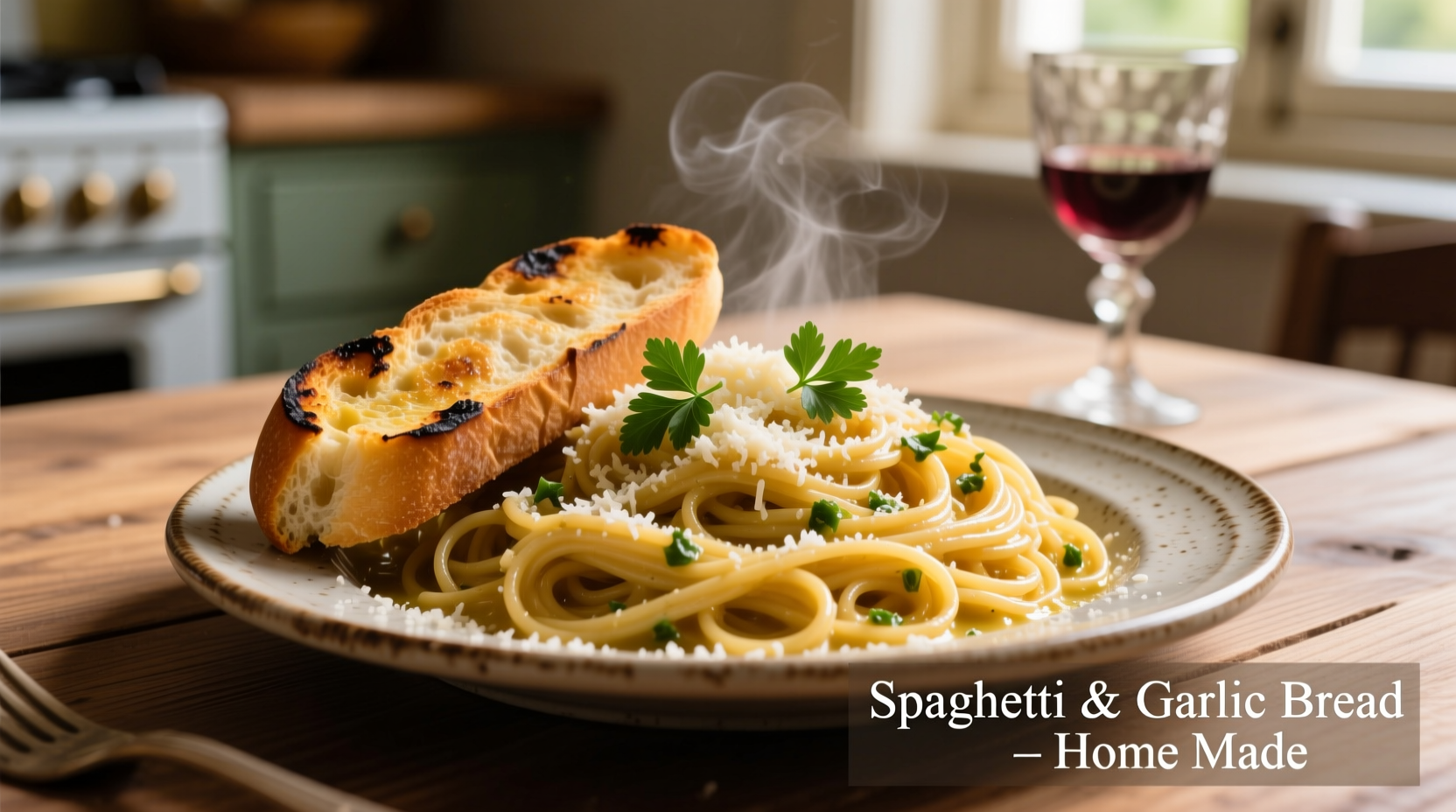Nothing satisfies like a plate of perfectly cooked spaghetti paired with warm, buttery garlic bread. This timeless Italian-American combination delivers the ideal balance of flavors and textures that has made it a favorite for generations. Our comprehensive guide reveals the professional techniques that transform this simple meal into a restaurant-quality experience.
The Perfect Harmony: Why Spaghetti and Garlic Bread Work So Well
Understanding the culinary science behind this pairing helps you maximize its potential. Spaghetti's neutral canvas absorbs rich tomato flavors while providing the perfect vehicle for twirling, and garlic bread's crispy texture creates a satisfying contrast to the tender pasta. The garlic's pungency cuts through the acidity of tomato sauce, creating a balanced flavor profile that satisfies multiple taste receptors simultaneously.
| Component | Flavor Contribution | Texture Role |
|---|---|---|
| Spaghetti | Neutral base for sauce absorption | Al dente chewiness |
| Tomato Sauce | Acidity and umami depth | Smooth coating |
| Garlic Bread | Rich buttery garlic notes | Crispy exterior, soft interior |
Essential Ingredients Checklist
Gathering quality ingredients before you begin ensures cooking success. Professional chefs emphasize ingredient quality as the foundation of exceptional results.
For Perfect Spaghetti
- 12 oz high-quality spaghetti (look for bronze-die extruded for better sauce adherence)
- 6 quarts water (proper water-to-pasta ratio prevents sticking)
- 3/4 cup coarse sea salt (not table salt) for proper seasoning
- 2 tbsp olive oil (added after cooking, not during)
For Authentic Garlic Bread
- 1 fresh baguette or Italian loaf (day-old works better for absorption)
- 6 tbsp unsalted butter, softened to room temperature
- 4 cloves fresh garlic, finely minced (about 2 tbsp)
- 2 tbsp fresh parsley, finely chopped
- 1/4 cup grated Parmesan cheese
- 1/4 tsp red pepper flakes (optional for heat)
The Science Behind Perfect Pasta Cooking
Understanding the food science transforms your results. When pasta enters boiling water, two critical processes occur simultaneously: starch gelatinization and protein coagulation. The ideal cooking temperature range of 195-212°F (90-100°C) allows starch granules to absorb water and swell while gluten proteins set properly.
According to research published in the Journal of Cereal Science, the optimal salt concentration in pasta water (0.5-1.5%) enhances flavor without significantly raising the boiling point. This precise salting creates properly seasoned pasta throughout, not just on the surface.
Step-by-Step Cooking Process
Timing is everything when preparing spaghetti with garlic bread. Follow this sequence to have both components ready simultaneously.
Phase 1: Prepare the Garlic Bread (15 minutes before pasta)
- Preheat oven to 375°F (190°C)
- Mix softened butter, minced garlic, parsley, Parmesan, and red pepper flakes
- Cut bread horizontally, spread mixture evenly on both sides
- Wrap in foil and bake for 10 minutes, then open foil for final 5 minutes for crispness
Phase 2: Cook the Spaghetti (12-15 minutes)
- Bring 6 quarts water to rolling boil
- Add 3/4 cup coarse sea salt
- Add spaghetti, stirring immediately to prevent sticking
- Cook for 8 minutes (2 minutes less than package instructions)
- Reserve 1 cup pasta water before draining
- Immediately toss with 2 tbsp olive oil
Phase 3: Finish the Meal (5 minutes)
- Toss spaghetti with your preferred sauce in a warm bowl
- Add reserved pasta water as needed to emulsify sauce
- Slice garlic bread into 1-inch pieces
- Serve immediately with extra Parmesan on the side

Avoiding Common Mistakes
Even experienced cooks make these critical errors that compromise results:
- Adding oil to cooking water - prevents sauce from adhering to pasta
- Overcooking pasta - destroys the ideal al dente texture (test 2 minutes before package time)
- Using pre-minced garlic - lacks fresh flavor and can become bitter when cooked
- Putting garlic bread directly on oven rack - causes uneven cooking and burning
Food Safety Considerations for Garlic Preparations
The USDA Food Safety and Inspection Service recommends specific guidelines for garlic-in-oil preparations to prevent botulism risk. Always use fresh garlic rather than pre-minced varieties in oil, and consume garlic bread within 2 hours of preparation. For longer storage, keep below 40°F (4°C) and consume within 3 days. The acidity from tomatoes in your sauce actually helps mitigate this risk when served together.
Customization Options for Dietary Needs
This classic pairing adapts beautifully to various dietary requirements:
- Gluten-free: Use certified gluten-free spaghetti and gluten-free bread
- Vegan: Substitute butter with vegan alternative and omit cheese
- Low-carb: Try zucchini noodles with traditional garlic bread
- Extra protein: Add cooked Italian sausage or meatballs to the sauce
Serving and Storage Guidance
For optimal enjoyment, serve spaghetti with garlic bread immediately after preparation. If you have leftovers, store components separately:
- Refrigerate pasta with sauce in airtight container for up to 3 days
- Store garlic bread wrapped in foil at room temperature for 1 day
- To reheat pasta, add splash of water and warm gently on stove (not microwave)
- Revive garlic bread by wrapping in foil and heating at 350°F for 5-7 minutes
Why This Classic Meal Endures
The pairing of spaghetti with garlic bread emerged in American Italian restaurants during the post-WWII economic boom. As documented by the Smithsonian National Museum of American History, Italian immigrants adapted traditional recipes using available American ingredients, creating this now-iconic combination. The timeline shows how garlic bread evolved from simple peasant food (pane all'aglio) to restaurant staple between 1945-1965, perfectly complementing the spaghetti that had already gained popularity.











 浙公网安备
33010002000092号
浙公网安备
33010002000092号 浙B2-20120091-4
浙B2-20120091-4